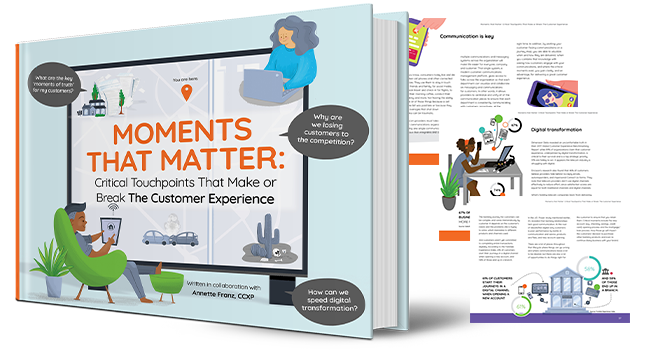The modern customer is drastically different than that of generations past. In 2017, there were 8 billion connected things, and, in 2020, those numbers are expected to reach up to 20 billion connected. Today’s customers are connected to global networks, interacting at the speed of light via social media. This means they have access to a constant stream of information and can deploy that knowledge however they wish. The connected customer expects businesses to rise to meet them on their terms and understanding how to do that is crucial to achieving company goals.
Meeting customers on their level
In order to better understand the connected customer, businesses have to first take inventory of their customer communications. It’s important to be aware of the purpose of those communications. For example, the insurance industry historically communicated through phone interactions related to billing and claims. Outside of cost, customers only had these limited transactional interactions to determine whether they considered a company to be good, and if they’d continue to use them for insurance. That is no longer the case. In fact, more than 50% of consumers say they actively seek to buy from innovative companies. The connected customer is more informed. They have the ability to navigate social media for direct lines of opinion when selecting an insurance provider. There are online forums they can gather information from, as well as more incident-based reporting, only a few clicks away.
The connected customer no longer accepts a transaction-only business model. The conflated processes of submitting forms in triplicate by mail and waiting weeks for a reply is now substandard. Customers have lost patience for simply calling a massive company phone centre, endlessly waiting in a queue to speak to a representative. Sixty-three percent of customers say they’re likely to switch companies if they’re treated like a number instead of an individual. The connected customer wants to complete simple forms and file claims online or via an app on their phone. They want not just streamlined processes but speedier decisions. Instead of connecting only by phone, insurers have recognized they must, at least, offer the ability to connect through social media. A lot of companies go one step further and have a plethora of customer service representatives available for an online text-based chat. Overall, the connected customer demands that businesses meet them on the channel of their choice.
Proactive vs. Reactive communication
In this continuously evolving, technology-fueled landscape, it is imperative businesses understand customers’ desire for proactive, as opposed to reactive, communications. Reactive communications are the old way of doing things. Think about insurance agents taking inbound calls from a customer after a medical procedure to complete the requisite paperwork, or banks mailing you overdraft receipts and fee notice days after the occurrence. While there is nothing inherently wrong with this communication process, proactive communication delivers more of what the connected customer expects. Customers are two times more likely to view personalized offers as important.
Engagement varies by industry. This can include forward-thinking ideas, such as health insurers sending SMS messages to customers informing them about free local flu shots. Credit card providers utilizing social media to post surveys about potential options for new member rewards. These are two examples of how organizations may use proactive communication to solicit input from both potential and current customers. Anything that helps create a conversation between customers and businesses is beneficial, even if many of those interactions aren’t human to human. In 2020, 85% of a customer’s relationship with a business will be managed without interacting with a person. However, the connected customer still desires more transparency, shorter response times, and to feel a part of the process. This means companies who focus on proactive communication tools, like allocating funds for AI chatbots, omnichannel communication buildouts and app development, will have a greater chance at maintaining success.
The need for an omnichannel strategy
There are many ways companies can meet customers at their increasingly demanding expectation levels. Those in the banking industry can allow emojis to be used as transaction descriptors or tags to build micro-moments of customer personalization. Many companies are adding voice recognition capabilities and dash buttons for speedier, more efficient customer logins. The changing customer landscape creates a fluctuating mix of informed, practical, and “brand influencer” customers. Essentially, they have done more research, prior to choosing a brand or service, and are willing to share that experience across their digital and social networks. This increases the importance of dedicated business resources focused on implementing a consistent, omnichannel strategy.
Those businesses that adapt and implement a omnichannel approach across the board achieve 91% greater year-over-year customer retention. Customers want to start a conversation with a virtual banking assistant on the phone, have details texted to them, and have the ability to complete the process via email. Insurance clients, for example, want to see plan options and details online before making a selection. They later want plan questions answered faster via AI interactions, while still being able to speak with a person when needed. It is paramount that customers have options for achieving real time answers and information because 64% of consumers expect companies to interact with them in real time.
The connected customer lives the always-on lifestyle by choice, which means they are inundated with communications from a variety of channels, from email to text to mobile app notifications, all day long. For businesses to thrive in this connected time, they must ensure their communications are timely, relevant, and seamless regardless of touchpoint and channel.
To learn more about how organizations can better adapt to the needs of the connected customer, grab a copy of our new eBook, “Moments that Matter: Critical Touchpoints that Make or Break the Customer Experience”.

